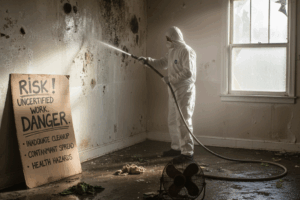
Indoor Air Quality Testing Equipment 2025 – Essential Tools for Accurate IAQ Results
Indoor air quality is under the spotlight in 2025. As wildfires, pollutants, and urbanization impact air across North America, accurate IAQ testing is more essential than ever. Professionals trained in our Certified Indoor Air Quality Testing Technician (CIAQTT) course rely on cutting-edge equipment to provide trustworthy results.
If you’re entering the field or upgrading your tools, here’s a breakdown of the top indoor air quality testing equipment to consider this year.
1. PM2.5 and PM10 Particulate Counters
These devices measure fine particles like dust, smoke, and pollen that can penetrate deep into the lungs. In 2025, real-time particle counters with laser sensors are more compact and accurate than ever.
Use Case: Wildfire-prone areas, urban homes, schools.
2. CO2 and CO Meters
Excess carbon dioxide can lead to fatigue and headaches, while carbon monoxide is deadly. Multi-sensor models now track both in real-time and log long-term trends.
Use Case: Offices, classrooms, apartments with poor ventilation.
3. VOC and Formaldehyde Detectors
Volatile Organic Compounds (VOCs) and formaldehyde are common in household cleaners, paints, and furniture. 2025 models now detect down to parts per billion (ppb) and are often integrated into handheld or wall-mounted monitors.
Use Case: New construction, post-renovation testing.
4. Humidity and Temperature Data Loggers
Humidity can drive mold growth while temperature affects comfort and pathogen survival. Smart loggers in 2025 now offer app syncing, cloud access, and battery life that lasts months.
Use Case: Mold inspections, HVAC diagnostics, basement testing.
5. Advanced Multi-Parameter IAQ Stations
These are all-in-one devices used by high-level professionals, capable of measuring up to 10+ parameters including CO2, VOCs, PM2.5, temperature, humidity, and even ozone or radon.
Use Case: Large commercial buildings, hospitals, indoor agriculture.
6. Radon Test Kits
While not new, radon detectors in 2025 are faster, more accurate, and often come with digital readouts. Some are now Wi-Fi enabled and offer ongoing monitoring.
Use Case: Basements, crawl spaces, pre-sale home inspections.
Are You Certified to Use This Equipment?
Using these tools correctly requires professional knowledge. That’s where IAQCert’s Certified Indoor Air Quality Testing Technician (CIAQTT) course comes in. You’ll not only learn what to test—but how to interpret results and recommend actionable solutions.
If you’re already certified in Certified Water Damage Restoration Technician (CWDRT) or Certified Mold Inspection Technician (CMIT), CIAQTT is the perfect upgrade.
Stay Ahead in 2025
Indoor air quality testing is no longer a luxury—it’s a necessity. With the right equipment and certification, you’ll stand out as a trusted expert in one of the fastest-growing segments of the environmental health industry.
Internal Links to Explore:
- Certified Building Biology Technician (CBBT)
- Certified Radon Investigation Technician (CRIT)
- All IAQCert Certification Courses
External Resources:



